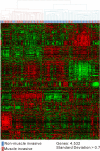Predictive value of progression-related gene classifier in primary non-muscle invasive bladder cancer
- PMID: 20059769
- PMCID: PMC2821358
- DOI: 10.1186/1476-4598-9-3
Predictive value of progression-related gene classifier in primary non-muscle invasive bladder cancer
Abstract
Background: While several molecular markers of bladder cancer prognosis have been identified, the limited value of current prognostic markers has created the need for new molecular indicators of bladder cancer outcomes. The aim of this study was to identify genetic signatures associated with disease prognosis in bladder cancer.
Results: We used 272 primary bladder cancer specimens for microarray analysis and real-time reverse transcriptase polymerase chain reaction (RT-PCR) analysis. Microarray gene expression analysis of randomly selected 165 primary bladder cancer specimens as an original cohort was carried out. Risk scores were applied to stratify prognosis-related gene classifiers. Prognosis-related gene classifiers were individually analyzed with tumor invasiveness (non-muscle invasive bladder cancer [NMIBC] and muscle invasive bladder cancer [MIBC]) and prognosis. We validated selected gene classifiers using RT-PCR in the original (165) and independent (107) cohorts. Ninety-seven genes related to disease progression among NMIBC patients were identified by microarray data analysis. Eight genes, a progression-related gene classifier in NMIBC, were selected for RT-PCR. The progression-related gene classifier in patients with NMIBC was closely correlated with progression in both original and independent cohorts. Furthermore, no patient with NMIBC in the good-prognosis signature group experienced cancer progression.
Conclusions: We identified progression-related gene classifier that has strong predictive value for determining disease outcome in NMIBC. This gene classifier could assist in selecting NMIBC patients who might benefit from more aggressive therapeutic intervention or surveillance.
Figures





Similar articles
-
Prognostic Value of BUB1 for Predicting Non-Muscle-Invasive Bladder Cancer Progression.Int J Mol Sci. 2021 Nov 25;22(23):12756. doi: 10.3390/ijms222312756. Int J Mol Sci. 2021. PMID: 34884561 Free PMC article.
-
Expression signature defined by FOXM1-CCNB1 activation predicts disease recurrence in non-muscle-invasive bladder cancer.Clin Cancer Res. 2014 Jun 15;20(12):3233-43. doi: 10.1158/1078-0432.CCR-13-2761. Epub 2014 Apr 8. Clin Cancer Res. 2014. PMID: 24714775
-
Predictive value of cadherin-11 for subsequent recurrence and progression in non-muscle invasive bladder cancer.Jpn J Clin Oncol. 2020 Apr 7;50(4):456-464. doi: 10.1093/jjco/hyz186. Jpn J Clin Oncol. 2020. PMID: 31894237
-
Molecular biomarkers of progression in non-muscle-invasive bladder cancer - beyond conventional risk stratification.Nat Rev Urol. 2025 Feb;22(2):75-91. doi: 10.1038/s41585-024-00914-7. Epub 2024 Aug 2. Nat Rev Urol. 2025. PMID: 39095581 Review.
-
Prognostic Implications of Immunohistochemical Biomarkers in Non-muscle-invasive Blad Cancer and Muscle-invasive Bladder Cancer.Mini Rev Med Chem. 2020;20(12):1133-1152. doi: 10.2174/1389557516666160512151202. Mini Rev Med Chem. 2020. PMID: 27173513 Review.
Cited by
-
RhoGDI2 suppresses lung metastasis in mice by reducing tumor versican expression and macrophage infiltration.J Clin Invest. 2012 Apr;122(4):1503-18. doi: 10.1172/JCI61392. Epub 2012 Mar 12. J Clin Invest. 2012. PMID: 22406535 Free PMC article.
-
Development of a propionate metabolism-related gene-based molecular subtypes and scoring system for predicting prognosis in bladder cancer.Eur J Med Res. 2024 Jul 29;29(1):393. doi: 10.1186/s40001-024-01982-6. Eur J Med Res. 2024. PMID: 39075554 Free PMC article.
-
Urothelial cancer gene regulatory networks inferred from large-scale RNAseq, Bead and Oligo gene expression data.BMC Syst Biol. 2015 May 14;9:21. doi: 10.1186/s12918-015-0165-z. BMC Syst Biol. 2015. PMID: 25971253 Free PMC article.
-
Tumor hypoxia in immune infiltration and prognosis of bladder cancer.Transl Cancer Res. 2024 Jul 31;13(7):3273-3284. doi: 10.21037/tcr-23-2375. Epub 2024 Jul 26. Transl Cancer Res. 2024. PMID: 39145090 Free PMC article.
-
Patient Mutation Directed shRNA Screen Uncovers Novel Bladder Tumor Growth Suppressors.Mol Cancer Res. 2015 Sep;13(9):1306-15. doi: 10.1158/1541-7786.MCR-15-0130. Epub 2015 Jun 15. Mol Cancer Res. 2015. PMID: 26078295 Free PMC article.
References
-
- Cordon-Cardo C, Zhang ZF, Dalbagni G, Drobnjak M, Charytonowicz E, Hu SX, Xu HJ, Reuter VE, Benedict WF. Cooperative effects of p53 and pRB alterations in primary superficial bladder tumors. Cancer Res. 1997;57:1217–1221. - PubMed
Publication types
MeSH terms
LinkOut - more resources
Full Text Sources
Other Literature Sources
Medical
Molecular Biology Databases

